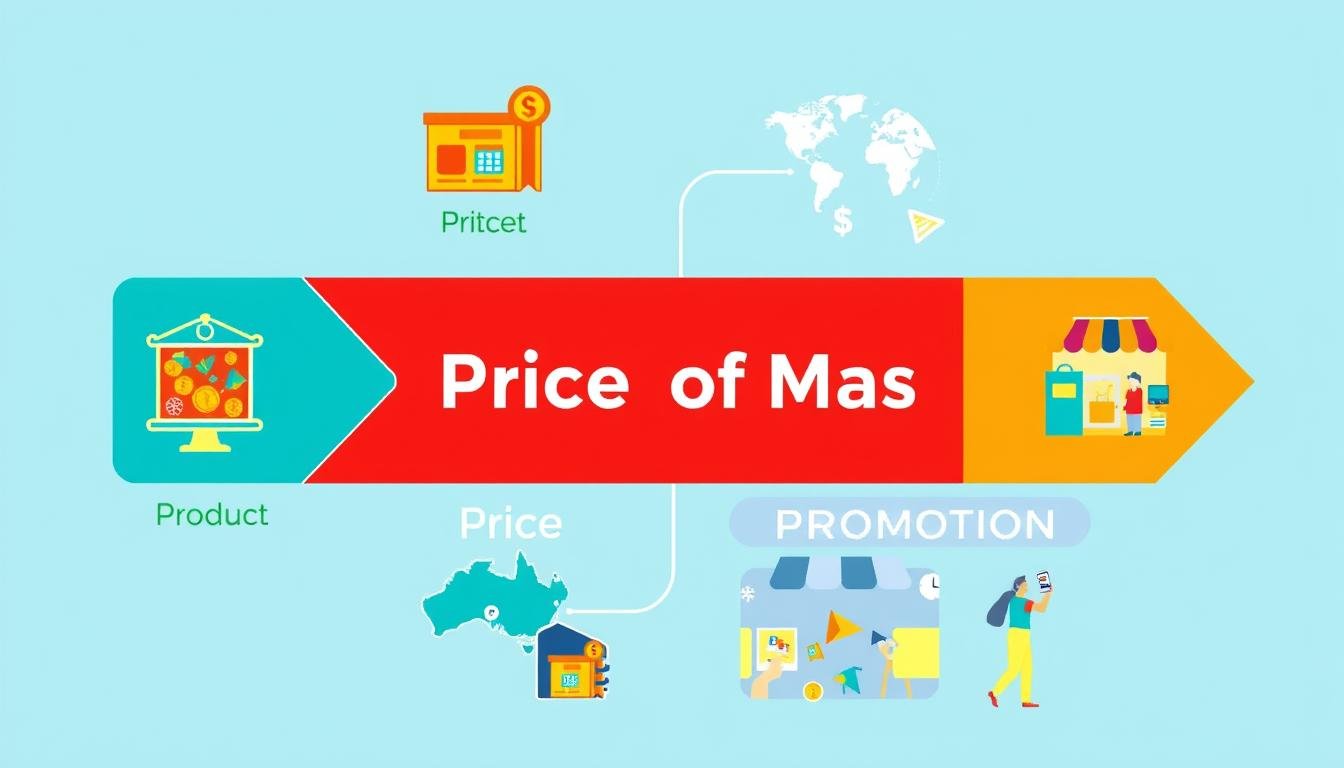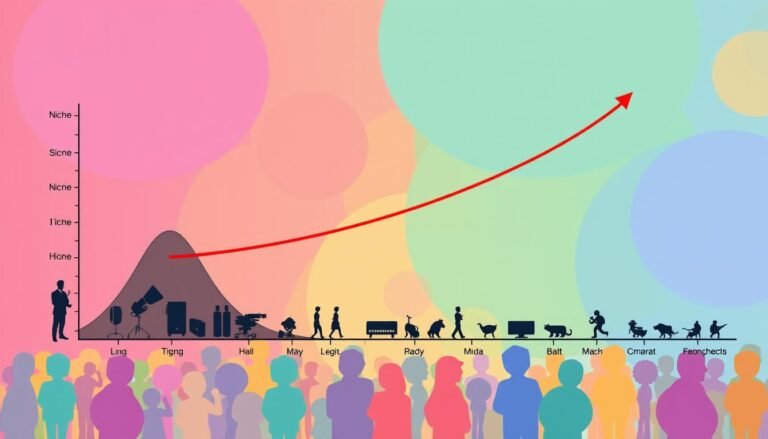Exploring the Four Ps of Marketing Mix Strategy
Ever wondered why some brands become superstars while others disappear? It’s often because of The Four Ps of Marketing. This key marketing mix helps businesses make their way through the complex world of business marketing. It guides them in creating strong marketing strategies. By focusing on Product, Price, Place, and Promotion, companies can boost their customer interaction and profits.
The Four Ps started in the 1950s and have grown to include more elements for today’s marketing. Brands like Apple, with $205.4 billion in iPhone sales in FY 2022, and Absolut vodka, which went from 10,000 cases in 1980 to 4.5 million by 2000, show how the 4Ps can lead to success.
Let’s dive into each part of the marketing mix. We’ll see how smart planning can change the game in a crowded market.
Key Takeaways
- The Four Ps of Marketing offer a structured way to craft strong marketing plans.
- Getting the Product right is key for brand success, as Apple shows with its constant innovation.
- Setting the right Price is about matching value with what customers expect in the market.
- How you distribute your product (Place) can really impact how easy it is for customers to buy it.
- How you promote your brand (Promotion) is crucial for sharing your message and connecting with customers.
- Today, the Four Ps have grown to include more elements, reflecting how customers experience brands.
Introduction to the Four Ps of Marketing
The The Four Ps of Marketing started in the 1950s. It includes Product, Price, Place, and Promotion. This method helps businesses make marketing plans that connect with customers. Each part of the framework plays a key role in how people see products and decide to buy them.
Product looks at quality, design, and how green a product is. These things are key to what customers want. Price is also crucial; for example, a price like $9.99 can make a product seem cheaper. There are different pricing strategies for different markets, like charging more for luxury items or selling at low prices.
Place is about how products get to customers. This can be through stores or online, like on Amazon. Promotion uses social media and ads to show customers why they should buy a product.
Knowing how these elements work together is important for a good marketing plan. For example, looking at each P can help spot where a marketing plan is weak. Using the Four Ps, companies can make products that go beyond what customers expect. This helps them stand out in the market.
| Component | Importance | Examples |
|---|---|---|
| Product | Essential for meeting consumer demands and preferences | Quality, design, packaging |
| Price | Critical for market positioning and sales | Psychological pricing, premium pricing |
| Place | Makes products accessible to target consumers | Brick-and-mortar, e-commerce |
| Promotion | Communicates value and encourages purchase decisions | Advertising, discounts, influencer marketing |
Understanding the Marketing Mix
The marketing mix has grown a lot since E. Jerome McCarthy introduced it in 1960. It’s about the key elements businesses use to promote their products and services. The Four Ps of Marketing – Product, Price, Place, and Promotion – are at the heart of this strategy.
Product means what businesses offer to customers. It’s about knowing what customers need and making sure the product meets those needs. Price depends on how much people want the product and how it compares to others. Setting the right price can really help get customers interested.
Place talks about how products get to customers. It’s about choosing the right ways to sell products. Promotion is how companies talk to their audience. They use ads, PR, and social media to make sure people hear their message.
But the Four Ps aren’t the only things that matter. People, Process, and Physical Evidence add more to the marketing mix. They help businesses understand how customers feel and what makes them happy.
| Element | Description | Importance |
|---|---|---|
| Product | The goods or services offered to meet consumer needs. | Aligns with consumer preferences to drive sales. |
| Price | The amount charged for the product. | Influences purchasing decisions and market competitiveness. |
| Place | The distribution channels used for products. | Determines accessibility and availability to target customers. |
| Promotion | The marketing communications strategy. | Engages consumers and generates awareness. |
Using the marketing mix well helps companies connect better with customers. It helps them stay competitive and successful.
The Four Ps of Marketing (Marketing Mix)
The Four Ps of Marketing are key to any marketing plan. They include Product, Price, Place, and Promotion. Each one is crucial for reaching customers well. By understanding these, marketers can make strategies that speak to their audience.
Definition of the Four Ps
The Four Ps of Marketing are important parts of success in marketing:
- Product: This is what you sell, meeting customer needs and standing out from others.
- Price: This is how much people pay, showing its value and how it compares to others.
- Place: This is about how and where products are sold to reach the right people.
- Promotion: This is how you tell people about your product and try to get them to buy it.
History and Evolution
The idea of the marketing mix has changed a lot since the 1960s. Neil Borden first talked about the Four Ps in his marketing talks. Later, E. Jerome McCarthy made these ideas clear in his book “Basic Marketing: A Managerial Approach.”
Over time, marketers added more elements like People, Process, and Physical Evidence. This made the 7 Ps of marketing.
This change shows how markets and customers change, making it vital for businesses to update their marketing plans. Using the Four Ps helps companies check their strengths and weaknesses. It also helps them stay competitive in today’s fast-changing world.
Product: Defining Your Offer
In marketing, making products that customers want is key. Brands need to know what people need and like. They must create products that meet these needs and stand out.
By planning well, researching, and innovating, brands can make sure their products match what consumers want. This helps strengthen their brand identity.
Importance of Product Development
Product development is crucial. It’s a big part of The Four Ps of Marketing. It affects how well the marketing mix works.
About 40% of new products don’t make it. To succeed, focus on quality, features, and the brand name. Knowing what customers want is also key to making products they’ll like.
Product Life Cycle Considerations
Knowing the product life cycle helps with marketing. Each stage—introduction, growth, maturity, and decline—needs a different marketing approach.
In the introduction stage, promote to get noticed. In the growth stage, adjust how you sell and price to meet demand.
Examples from Successful Brands
Brands like Nike know how to use The Four Ps well. Their shoes are innovative and high-quality. They combine great design with what customers want, making them a top choice in sports gear.
| Brand | Product Example | Key Success Factors |
|---|---|---|
| Nike | Air Max | Innovative design, strong branding, customer loyalty |
| Apple | iPhone | Cutting-edge technology, premium pricing, market positioning |
| Coca-Cola | Coca-Cola Classic | Effective promotion, global distribution, brand recognition |
Pricing Strategy: Setting the Right Price
Creating a good pricing strategy means knowing about price factors. Many things affect how much you charge, like making costs, what others charge, and what customers want. It’s important to study the market well to find a price that fits your goals and what customers expect. The right price shows quality and shapes how people see your product.
Factors Influencing Price Decisions
Many price factors are key to setting a product’s price. These include:
- Cost of production: This is the starting point for setting prices.
- Competitive pricing: Knowing what others do helps with your position.
- Market demand: If demand is high, you might charge more.
- Consumer perception: Brands shape how people see their products.
- Price skimming: Launching at high prices and then lowering them.
- Penetration pricing: Starting with low prices to quickly gain market share.
- Value-based pricing: Pricing based on what the consumer values the product as.
Perceived Value vs. Actual Cost
It’s crucial to know the difference between what people think a product is worth and its real cost in a pricing strategy. Often, customers decide based on what they think a product is worth, not its actual cost. Making a product seem more valuable can really change how people buy it. Good marketers share what makes their product special, making the price seem right to customers.
Place: Distribution Channels and Accessibility
Choosing the right places to sell products is key to reaching your audience. The Place aspect in marketing is vital for making sure products are easy to find. It shapes how and where people can buy things. Knowing how to use distribution channels well can greatly help a company connect with customers and boost sales.
Choosing the Right Sales Channels
There are three main ways to distribute products: intensive, selective, and exclusive. Companies that sell everyday items often use an intensive approach to be in many places. This helps them catch impulse buyers. For example, snack and drink brands do this well.
For tech products like computers, a selective approach is better. It lets customers compare different options in special stores. On the other hand, exclusive distribution is for luxury items, like fancy cars. It gives ongoing support to users.
So, companies need to think about what customers like and what their products are like to pick the best sales channels.
Online vs. Brick-and-Mortar Strategies
E-commerce has changed how we shop, but physical stores are still important. They offer a better shopping experience. The way a store looks affects how customers feel about it and what they decide to buy.
Online shopping offers wide reach and can be cheaper. But, stores let customers talk directly with sales staff. Each way to sell has its own pros and cons.
Understanding distribution channels is key to the Four Ps of Marketing. Companies know that using middlemen like agents and retailers can be helpful. They speed up getting products to customers and add value. But, companies also need to watch out for the costs of using these channels, like losing direct communication and product value.
To make the most of their marketing, businesses should think about these points. This way, they can meet customer needs and do well in the market.
| Distribution Strategy | Typical Usage | Main Characteristics |
|---|---|---|
| Intensive Distribution | Consumer Goods | Widely available, frequent impulse purchases |
| Selective Distribution | Technology Products | Limited outlets, allows for comparison |
| Exclusive Distribution | Luxury Products | High-end, personalized customer service |
Promotion: Communicating with Your Audience
Promotion is key in marketing. It lets companies share their value with consumers. A good promotional strategy uses digital marketing, traditional ads, PR, and events. These methods help make brands known and boost sales through smart marketing channels.
Types of Promotional Strategies
Brands use many ways to connect with their audience. Some common strategies are:
- Digital Marketing: Using social media and search engines to reach out to people.
- Advertising: Ads in TV, print, and online to get the word out.
- Public Relations: Making a good name through media and public outreach.
- Events and Sponsorships: Creating experiences that get people talking about the brand.
- Content Marketing: Sharing content that informs or entertains, building loyalty.
Online platforms have changed how luxury brands talk to people. About 40% of luxury buys are swayed by online experiences. By 2025, online luxury sales are set to triple. This shows how crucial a strong online strategy is for luxury brands to stay ahead.
Measuring Promotion Effectiveness
It’s vital to see how well promotional strategies work. Marketers use different metrics to check this:
| Metric | Description | Example |
|---|---|---|
| Engagement Rates | How much people interact with content | Likes, shares, and comments on social media |
| Sales Conversion | How many leads turn into sales | Number of purchases from a campaign |
| Brand Awareness | How well people know a brand | Surveys or studies on brand recall |
Using A/B testing in digital campaigns shows what works best. By always improving their strategies, businesses can keep their marketing in line with what consumers like.
Applying the Four Ps in Business Marketing
Using the Four Ps with deep market analysis boosts marketing efforts. It helps marketers understand trends, consumer habits, and the competition. This knowledge guides decisions on product features, prices, where to sell, and how to promote.
Regular market analysis lets marketers tweak their strategies. This keeps the marketing plan strong and effective over time.
Linking the Four Ps with Market Analysis
Companies that use the Four Ps well meet customer needs better. A study by Forrester showed big wins for those focusing on customers. Customer-focused firms saw margins jump by 62%, while others only saw a 45% increase.
This shows how market analysis drives the Four Ps for better results. Also, 54% of companies found more loyal customers through good omnichannel marketing. This proves how the right use of the Four Ps boosts customer loyalty.
Case Study: Successful Implementation of the Four Ps
UNIQLO is a great example of the Four Ps in action. They offer quality clothes at good prices. Their pricing and promotions use digital marketing and influencer partnerships to reach more people.
This approach has boosted customer engagement and made UNIQLO a top choice online and in stores.
Conclusion
The Four Ps of Marketing are key for businesses looking to boost their marketing. Neil Borden first introduced them in 1964, and Jerome McCarthy later expanded on them. This model includes Product, Price, Place, and Promotion. It helps marketers meet consumer needs effectively.
Each part of the Four Ps is important. Businesses must think about the product life cycle and how to price things. They also need to make sure their products are easy to get and promote them well.
As marketing changes, adding new parts like people, physical evidence, and processes is crucial. Reviewing and improving these parts helps businesses stay successful. It also helps them stand out from competitors.
Source Links
- The 4 Ps of Marketing: What They Are & How to Use Them Successfully
- The 4 Ps of Marketing: What They Are and How to Use Them
- What Are the 4 Ps of Marketing? The Marketing Mix Explained [Example]
- The 4 Ps Of Marketing
- The Four Ps of Marketing
- Marketing Mix: The 4 Ps of Marketing and How to Use Them
- What is the Marketing Mix (4 P’s of Marketing)?
- What Is The Marketing Mix? 4Ps & 7Ps of Marketing
- 4 P’s of Marketing: Achieve the Perfect Marketing Mix [2024] • Asana
- The Four Ps of Marketing Explained
- Marketing mix 101: How to use the 4 Ps of marketing
- Marketing’s Four P’s: First Steps for New Entrepreneurs EC-730
- What Are the 4 Ps of Marketing and Are They Relevant?
- The 5 most common pricing strategies
- Marketing strategy | Marketing mix: product, price, place & promotion | Entrepreneur’s Toolkit
- The Four Ps of Marketing: How to Master the Marketing Mix
- "Place" in the 4Ps of Marketing Mix – ExportPlanning
- Marketing Mix | Place in Four P’s
- A Comprehensive Guide to Implementing the 4 Ps of Marketing
- The 4 Ps of Marketing: How to Strategize Your Marketing Mix – Zoviz Blog
- Marketing Mix Modeling: The Four Ps and Beyond
- Understanding the 4 Ps of Marketing Through Digital Transformation
- The 4 Ps of Marketing
- 4 P’s of Marketing
- 4Ps of Marketing: The ultimate guide – Fynzo®







